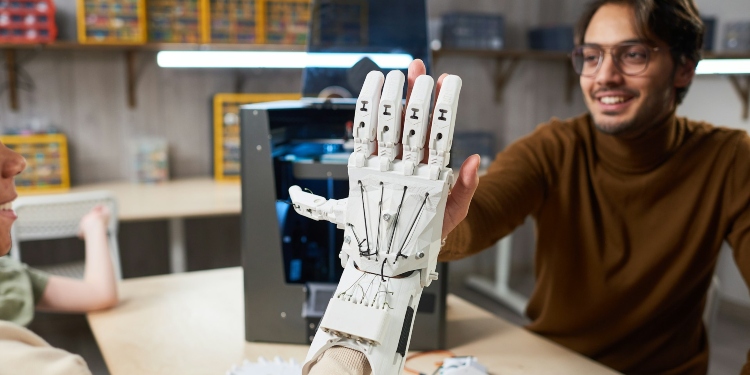In recent decades, we have witnessed the rapid development of technologies that are changing our lives. Artificial intelligence plays a central role in this process, especially in the field of robotics. It is becoming not only a powerful tool but also a reliable partner capable of performing a wide range of tasks. How exactly does AI influence the development of robots, and what awaits us in the future? Let’s explore.
Transforming the Industry
Artificial intelligence brings capabilities to robotics that once seemed unattainable. Modern robots equipped with AI can perform tasks with a high degree of precision and efficiency, significantly increasing their productivity. These devices are becoming more autonomous, able to adapt to changing conditions and learn from the data they receive. To delve deeper into these advancements, consider enrolling in an MIT AI course to gain cutting-edge knowledge about AI and its applications in robotics.
One of the key areas of AI application in robotics is industry. For example, in manufacturing processes, robots can automatically adjust their actions based on changing conditions on the assembly line, significantly reducing downtime and increasing overall productivity. However, AI is not limited to industrial applications; it also finds its place in fields such as medicine, agriculture, and even service industries.
AI in Creative Work: Partners in Creativity
Modern technologies are increasingly penetrating the creative sphere, where artificial intelligence plays a key role. We are seeing a growing interest in creative robots that can assist people in various creative processes. These devices do not merely perform routine tasks; they become partners in creating art, music, and design. For instance, robots can generate unique artworks by combining different styles and techniques, opening new horizons for self-expression.
Creative algorithms utilizing machine learning can analyze user preferences, suggest various options, and adapt to changing conditions. This allows them not only to improve their results but also to create truly unique works that can inspire artists and designers. In this context, applications like DeepNude AI demonstrate how AI can process images and provide users with new visual interpretations of their photographs. These technologies allow users to upload their own images and receive unexpected results, enabling them to see their visuals in an entirely new light.
Such collaboration between humans and AI not only fosters creativity but also creates new forms of art. For example, in music, AI can analyze melodies and suggest new compositions based on user-defined genres and styles. This not only expands the possibilities for self-expression but also helps find inspiration in unexpected places. Thus, creative robots become true allies, helping people explore new ideas and forms beyond traditional boundaries.
In the end, this partnership opens doors to new forms of art and self-expression, allowing each user to relax and experience the joy of creativity through interaction with modern technologies.
Prospects of AI in Robotics
With each passing year, we see AI penetrating deeper into various areas of robotics. The future we can expect represents a combination of high technology and human creativity. The emergence of more complex and intelligent robots opens up new possibilities for their application in human life.
For example in medicine, we anticipate the development of surgical robots capable of performing operations with high precision, significantly reducing the risk of errors. In agriculture, robots can not only cultivate fields but also analyze data on plant conditions, helping farmers optimize the growing process. This will improve product quality and reduce costs, which is crucial in today’s market.
In the future we can expect improved interaction between humans and robots. Thanks to AI, robots will not only execute commands but also anticipate human needs, becoming true assistants in various areas of life. Such technological advancements allow us not only to enhance quality of life but also to free up time for more meaningful pursuits, enabling us to focus on creativity and self-actualization.
Ethical and Social Aspects
Despite all the advantages that AI brings, we must also consider the challenges associated with its use. Questions of ethics and responsibility are becoming increasingly relevant. How can we protect user data? How can we avoid abuses and manipulations with robots? Answers to these questions require a comprehensive approach, including the development of new rules and norms.
It’s important to remember that the implementation of AI in various fields may lead to changes in the job market. Some professions may disappear, while others will emerge, requiring new skills and knowledge. It is crucial to prepare society for these changes by teaching people to work with new technologies and developing skills that cannot be automated.
Conclusion
Artificial intelligence in robotics is not just a technology; it is a powerful tool that opens new opportunities for humanity. It has the potential to improve quality of life, enhance process efficiency, and help address many modern challenges. However, along with this, new challenges arise that require our attention.
The future in which AI and robots become our reliable assistants looks promising. A key aspect remains society’s readiness to adapt to new conditions and utilize these technologies for the common good. Only then can we truly appreciate all the benefits that artificial intelligence brings and make our world more convenient and progressive.
David Prior
David Prior is the editor of Today News, responsible for the overall editorial strategy. He is an NCTJ-qualified journalist with over 20 years’ experience, and is also editor of the award-winning hyperlocal news title Altrincham Today. His LinkedIn profile is here.












































































